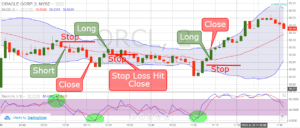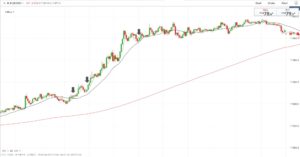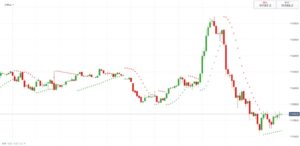Scalping Trading UK Guide 2026
Scalping trading is a popular day trading strategy. With scalping trading in the UK, the goal is to win as many small trades as possible. Over the course of a day, many small winning trades can add up.
Want to jump into scalping trading? We’ll explain how UK scalping trading works and highlight popular scalping trading systems. We’ll also take a look some UK brokers you can use to start scalping today.
What is Scalping Trading?
Scalping trading is a style of trading in which the goal is to profit from many small trades rather than a few large ones. Scalping trading strategies are generally used by day traders. The majority of scalping trades in the UK are opened and closed over a timespan of just a few minutes.
The idea behind scalping is that once a price movement starts, it’s likely to continue for some amount of time. However, UK scalping traders don’t assume that a price movement will stick around for long.
Instead of trying to profit off of an entire price movement, the idea behind scalping trading systems is to trade only the strong initial movement. By limiting a trade to this small portion of a price movement, the chances that your trade will succeed go up significantly. The trade-off is that by exiting a trade early, you limit the potential profit that any single trade can bring in.
To make money, most day trading strategies built around scalping call for placing a lot of trades. If you place 50 trades in a day that each earn 0.1% returns, that adds up to a 5% return by the end of the day.
Managing risk when scalping trading in the UK is extremely important, though. A single bad trade must not be allowed to wipe away a whole day’s worth of profits. Scalping trading systems almost always entail placing stop losses on every trade so that the maximum loss if a trade goes against you is limited.
What Assets are Suitable for Scalping?
Scalping trading systems can be used for just about any tradable asset. Stock trading and forex trading are particularly suited for scalping strategies since these assets tend to be very volatile. The higher the price volatility, the more opportunities for scalping trading.
On top of that, stocks and forex are highly liquid. This means that scalping traders won’t have any trouble entering and exiting positions.
Other types of trading, like ETF trading, commodity trading, and cryptocurrency trading, can all use scalping trading systems as well. However, keep an eye on liquidity. Gold trading and oil trading are highly liquid markets, for example, but scalpers may not be able to exit positions quickly when trading less popular commodities like cocoa.
Note that options trading using a scalping strategy is possible. However, this is relatively risky since options trades are always leveraged and liquidity for options contracts can be very low.
Scalping Trading Strategies
Succeeding with scalping trading in the UK requires having a clear scalping trading strategy. Your strategy should offer clear entry and exit points for every trade. The more that you can remove emotional decision-making from scalping trading, the more streamlined your trading will be.
Stock and forex trading scalping strategies can be as simple or as complex as you like. However, since scalping is fast-paced, simple is generally better. Let’s take a look at three day trading strategies for scalping trading that are built on individual technical indicators.
Moving Average Trading
Moving averages of the price can be used to form a basic scalping trading strategy. First, look at a long moving average like a 200-minute average to gauge the direction of the long-term trend. Then compare two shorter moving averages, like the 5-minute and 20-minute moving averages.
If the 200-minute average is trending bullish, you can enter trades when the 5-minute moving average crosses above the 20-minute moving average. Often, this will be the start of a short but powerful upward price movement. Exit the trade at the first sign of weakness – don’t wait for the 5-minute moving average to cross back below the 20-minute moving average.
Parabolic SAR Trading
A particularly good forex trading scalping strategy revolves around the parabolic SAR (stop and reverse) indicator. This technical indicator looks at price momentum to predict whether a bullish or bearish trend is underway.
Parabolic SAR appears as dots on a price chart. When the dots are below the current price bars, the price action is bullish. When the dots are above the current price bars, the price action is bearish. You can enter a trade as soon as the parabolic SAR switches from above to below or vice versa. Exit your trade as soon as the price momentum begins to fade.
Stochastics Oscillator Trading
When the market is moving sideways rather than in a specific bullish or bearish direction, the stochastic oscillator can be used to build a scalping trading system. This oscillator consists of two lines – a fast-responding %K line and a slow-responding %D line.
When the %K line crosses above the %D line, it means that price action has turned bullish in the short term. This is an opportunity to buy the underlying asset and capture a short upward price movement. Exit the position either when the %K line crosses back below the %D line or when %K reaches a value of 80 or more (which is near the top of its range).
Features of Scalping Trading UK
Scalping trading isn’t always the easiest style of trading. It takes a significant amount of focus and dedication. To make a worthwhile profit from scalping trading in the UK, you need to be glued to the market day in and day out. Placing hundreds of trades per day is time consuming.
That said, day trading with a scalping strategy has some important features over other types of trading.
First, the risk of any individual trade is low. If a trade loses more than, say, 0.1%, you’ll automatically exit it with most scalping strategies. So even if you are wrong about a trade, the amount of money you will lose as a result is relatively small.
Placing stop losses can help automate this risk management. Many UK scalping traders place stop losses with every trade to help remove downside risk.
Another reason investors use scalping trading systems is that they provide plenty of trading opportunities. Scalping traders don’t need to be tied to any single pattern or technical indicator, like some other types of traders. They can also look for opportunities across assets, and many forex trading scalping strategies work just as well for stocks or cryptocurrencies.
On top of that, small moves are simply more frequent in the market than large moves. Scalpers are trading the price action that happens normally throughout the day, rather than waiting for once-a-day jumps in price. As a result, there are more opportunities to trade each day.
Risks of Scalping Trading
While the risk of any individual scalping trade is low, scalping trading as a whole still carries significant risks for UK traders. Just as profits can add up over dozens or hundreds of trades, so can losses. If you lose a large fraction of your scalping trades, you could end up losing money from scalping trading.
It’s also important to keep in mind that scalping trading successfully requires a great deal of attention. You must be constantly monitoring your trades as well as searching for the next trading opportunity. It’s possible to profit from scalping trading, but to place too few trades in a day to make very much money.
Popular Scalping Trading Platforms
Choosing a reliable and cost-effect trading platform is one of the most important aspects of scalping trading. Commissions and fees can eat away at the profits from your trades, so you may wish to use a commission-free UK brokerage. You’ll also want to ensure that your brokerage offers a wide variety of assets to trade so that you can easily jump between the forex, stock, and other markets.
Another thing to consider is your broker’s trading platform. Scalping trading strategies require that you have access to advanced charting capabilities and technical indicators. Fast order entry can also make a big difference since trades must be opened and closed quickly.
With all that in mind, let’s take a look at two of the most popular UK scalping trading platforms that you can start using.
How to Start Scalping Trading
Ready to jump into scalping trading in the UK? We’ll show you how to get started with an FCA-regulated broker:
Step 1: Open a Scalping Trading Account
In order to start scalping trading in the UK, you’ll need to open a brokerage account. Head to your chosen broker’s website and sign up. Enter a new username and password for your account, then fill in personal details like your name, email, and birthdate.
If your broker is regulated by the UK’s Financial Conduct Authority, you’ll have to verify your identity. Upload a copy of your passport or driver’s license and a copy of a recent financial statement or utility bill to complete this step.
Step 2: Fund Your Account
You can deposit funds into your account using a wide variety of methods. Most brokers support debit and credit cards, e-wallets like Neteller and Skrill, and bank and wire transfers. Keep in mind that you must make a minimum deposit with many brokers.
Step 3: Place Your First Scalping Trade
Now you’re ready to start trading. Choose an asset to trade by searching for it your dashboard, then click ‘Trade’ to open a new order form.
In the order form, enter how much you want to trade. You can also set stop loss and take profit levels, which we recommend for scalping trading. Finally, select whether you want to add leverage to your trade (if trading CFDs).
When you’re ready, click confirm the position to open your first UK scalping trade.
Conclusion
Scalping trading in the UK is a high-frequency trading strategy that entails placing a lot of small trades. The advantage to scalping trading systems is that the risk of any single trade is relatively limited. However, you must pay close attention to the markets throughout the day in order to succeed with scalping trading.
If you’d like to start scalping trading, it’s wise to partner with an FCA-regulated broker and never invest more than you can afford to lose.



